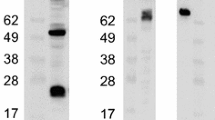Summary
The influence of genetic properties of parts of the HSV-1 genome on suppression of humoral antibody formation was investigated by using intratypic recombinants. The deleted strain HFEM (HSV-1) induces suppression. The MluI DNA fragment (coordinates 0.7615–0.796 m.u.) derived from the antibody inducing strain F1 (HSV-1) was transfected into the deleted strain HFEM to produce the recombinant virus R-MlCI and shown to restore antibody formation, as demonstrated by neutralization- and ELISA-tests. The intratypic recombinant viruses R-15, R-19 and R-26, produced by transfection of the Bam HI DNA-fragment B (0.738–0.809 m.u.) of strain Fl into the deleted strain HFEM, resulted in antibody formation only in the recombinant virus R-26. The reason for these different properties might be associated with the presence of small deletions in the Sma I A-fragment (0.763–0.765 m.u.) or elsewhere in the Bam HI DNA-fragment B. Our results were finally correlated to replication of the recombinant viruses in macrophages and to spread into spleen and adrenal glands. There is evidence that antibody formation may be correlated to the ability of HSV to replicate in macrophages.
Similar content being viewed by others
References
Becker Y (1987) The need for characterization of pathogenicity genes of recombinant DNA viruses used as human vaccines. Virus Genes 1: 117–120
Becker Y, Hadar J, Tabor E, BenHur T, Raibstein I, Rösen A, Darai G (1986) A sequence in Hpa I-P fragment of Herpes simplex virus-1 DNA determines intraperitoneal virulence in mice. Virology 149: 224–259
BenHur T, Moyal M, Rösen-Wolff A, Darai G, Becker Y (1989) Characterization of RNA transcripts form Herpes simplex virus-1 DNA fragment Bam HI-B. Virology 169: 1–8
BenHur T, Rösen-Wolff A, Lamade W, Darai G, Becker Y (1988) HSV-1 DNA sequence determining intraperitoneal pathogenicity in mice is required for transcription of viral immediate — early genes in macrophages. Virology 163: 397–404
Deres K, Schild H, Weismüller HH, Jung G, Rammensee H-G (1989) In vivo priming of virus-specific cytotoxic T-lymphocytes with a synthetic lipopeptide vaccine. Nature 342: 561–564
Ejercito PM, Kieff ED, Roizman B (1968) Characterization of herpes simplex virus strains differing in their effects on social behaviour of infected cells. J Gen Virol 2: 357–364
Görtz J, Brake B, Härle-Grupp V, Falke D (1984) Replication of HSV-1 in murine peritoneal macrophages: comparison of various strains with different properties. Arch Virol 79: 173–187
Kaerner HC, Hartmann OH, Schotten R, Schröder HC, Grey EP (1981) Amplification of a short nucleotide sequence in the repeat units of defective Herpes simplex virus type 1 angelotti DNA. J Gen Virol 39: 75–81
Kampe P, Knoblich A, Dietrich M, Falke D (1985) Differences in humoral immunogenicity between Herpes simplex virus types 1 and 2. J Gen Virol 66: 2215–2223
Koch HG, Rösen A, Ernst F, Becker Y, Darai G (1987) Determination of nucleotide sequence flanking the deletion (0.762–0.789 map units) in the genome of an intraperitoneally virulent HSV-1 strain HFEM. Virus Res 7: 105–115
Lopez C, Dudas G (1979) Replication of Herpes simplex virus type 1 in macrophages from resistant and susceptible mice. Infect Immun 23: 432–437
McGeoch DJ, Dalrymple MA, Davison AJ, Dolan A, Frame MC, McNab D, Perry LJ, Scott JE, Taylor P (1988) The complete DNA sequence of the long unique region in the genome of Herpes simplex virus type 1. J Gen Virol 69: 1531–1574
Metzger B (1988) Die Analyse der HSV-induzierten Suppression der Antikörperbildung mittels intertypischer Rekombinanten, ts-Mutanten und ausgewählter HSV-Stämme. Doctoral Thesis, Johannes Gutenberg University, Medical Faculty, Mainz, Federal Republic of Germany
Metzger B, Podlech J, Müller S, Falke D (1988) Suppression of humoral immune response against Herpes simplex virus induced by defective strains, ts- and TK−-mutants. Arch Virol 99: 143–152
Moyal M, Raibstein I, Rösen A, Darai G, Becker Y (1988) Heterogenicity of Bam HI DNA fragment B in several HSV-1 strains and recombinants. Virus Genes 1: 165–174
Nick S, Kampe P, Knoblich A, Metzger B, Falke D (1986) Suppression and enhancement of humoral antibody formation by herpes simplex virus types 1 and 2. J Gen Virol 67: 1015–1024
Nick S, Metzger B, Jonsic S, Falke D (1987) Suppression of humoral antibody formation against sheep red blood cells by infections with HSV-2 and the influence of mouse cytomegalovirus. Arch Virol 97: 131–135
Potratz D, Brake B, Dienes HP, Schulz TH F, Hosp M, Dierich MP, Falke D (1986) Herpes simplex virus type 1 and 2 in the adrenal glands: replication and histopathology. Arch Virol 90: 207–222
Rösen A, Ernst F, Koch HG, Gelderblom H, Darai G, Hadar J, Tabor E, BenHur T, Becker Y (1986) Replacement of the deletion in the genome (0.762–0.789 m.u.) of a virulent HSV-1 HFEM using cloned Mlu I DNA fragment (0.7615–0.796 m.u.) of virulent HSV-1 F leads to generation of virulent intratypic recombinant. Virus Res 5: 157–175
Thompson RL, Devi-Rao GV, Wagner EK (1988) DNA-sequence and RNA transcription through a site of recombination in a non-neuro-virulent herpes simplex virus intertypic recombinant. Virus Genes 1: 275–286
Author information
Authors and Affiliations
Rights and permissions
About this article
Cite this article
Wollert, K., El Ansari, T., Rösen-Wolff, A. et al. The region 0.7615–0.796 m.u. of the HSV-1 genome determines suppression of humoral antibody formation against herpes simplex virus. Archives of Virology 116, 175–184 (1991). https://doi.org/10.1007/BF01319240
Received:
Accepted:
Issue Date:
DOI: https://doi.org/10.1007/BF01319240




